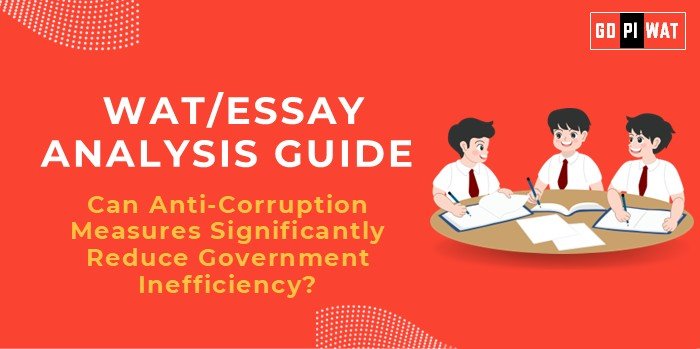📋 WAT/Essay Analysis Guide: Can Anti-Corruption Measures Significantly Reduce Government Inefficiency?
🌐 Understanding the Topic
Corruption drains resources, slows economic growth, and erodes institutional integrity. Anti-corruption measures aim to build transparent systems, fostering efficiency and public trust—critical traits in modern governance.
📝 Effective Planning and Writing
- ⏱️ Time Allocation:
- Planning: 5 minutes.
- Writing: 20 minutes.
- Review: 5 minutes.
- 📘 Preparation Tips:
- Identify key facts and examples like India’s DBT and Estonia’s e-governance.
- Develop balanced arguments incorporating achievements and challenges.
💡 Introduction Techniques for Essays
- ⚖️ Contrast Approach: “While global corruption costs $2.6 trillion annually, measures like DBT in India have saved over ₹2.7 lakh crore by curbing inefficiency.”
- 📖 Case-Based: “Estonia’s e-governance reforms saved over 800 years of working time, proving that transparency breeds efficiency.”
📚 Structuring the Essay Body
🏆 Achievements
- ✅ India’s DBT (Direct Benefit Transfer): Saved ₹2.7 lakh crore by eliminating middlemen.
- 💳 UPI: Streamlined digital payments and reduced transactional inefficiencies.
- 🌍 Estonia’s E-Governance: Reduced bureaucracy, saving over 800 years of working time.
⚠️ Challenges
- 🔒 Persistent Corruption: Deep-rooted issues in the public sector hinder progress.
- 📡 Cybersecurity Risks: Increased reliance on digital systems makes them vulnerable to attacks.
- 📉 Rural Connectivity Gaps: Limited digital access in remote areas slows reform adoption.
🔮 Recommendations
- 🤖 AI Integration: Leverage artificial intelligence for real-time monitoring of government processes.
- 🌐 Digital Literacy: Improve rural connectivity and provide training to bridge digital divides.
- ⚖️ Judicial Reforms: Strengthen enforcement mechanisms to ensure accountability.
📄 Concluding Effectively
- ⚖️ Balanced Conclusion: “Anti-corruption measures have demonstrated significant potential, but their true impact depends on addressing systemic barriers and fostering inclusivity.”
- 🌟 Visionary Conclusion: “With innovations like AI and blockchain, the future of governance could be transparent and efficient, inspiring global benchmarks.”
📊 Analyzing Successes and Shortcomings
🌟 Successes
- ✅ E-governance reforms in India have improved efficiency and reduced corruption.
- 🌍 Estonia has set global standards for digital governance with transparent systems.
⚠️ Challenges
- 🔒 Persistent corruption in rural and underdeveloped areas.
- 📉 Weak enforcement frameworks that fail to deter malpractice.
✨ Recommendations for Sustainable Progress
- 🤖 Leverage AI for real-time monitoring and fraud detection.
- 🌐 Invest in rural connectivity and digital infrastructure to expand access.
- ⚖️ Strengthen judicial and enforcement frameworks to ensure accountability and reduce delays.
✍️ Sample Short Essays
⚖️ Balanced Perspective:
“Anti-corruption measures like DBT and UPI demonstrate potential for reducing inefficiency, but gaps in rural connectivity and judicial enforcement hinder comprehensive impact.”
💡 Solution-Oriented:
“AI-driven governance tools and judicial reforms can accelerate anti-corruption efforts, paving the way for transparent and efficient public systems.”
🌍 Global Comparison:
“India can emulate Estonia’s e-governance success by prioritizing digital reforms and inclusive policymaking to combat inefficiency.”


